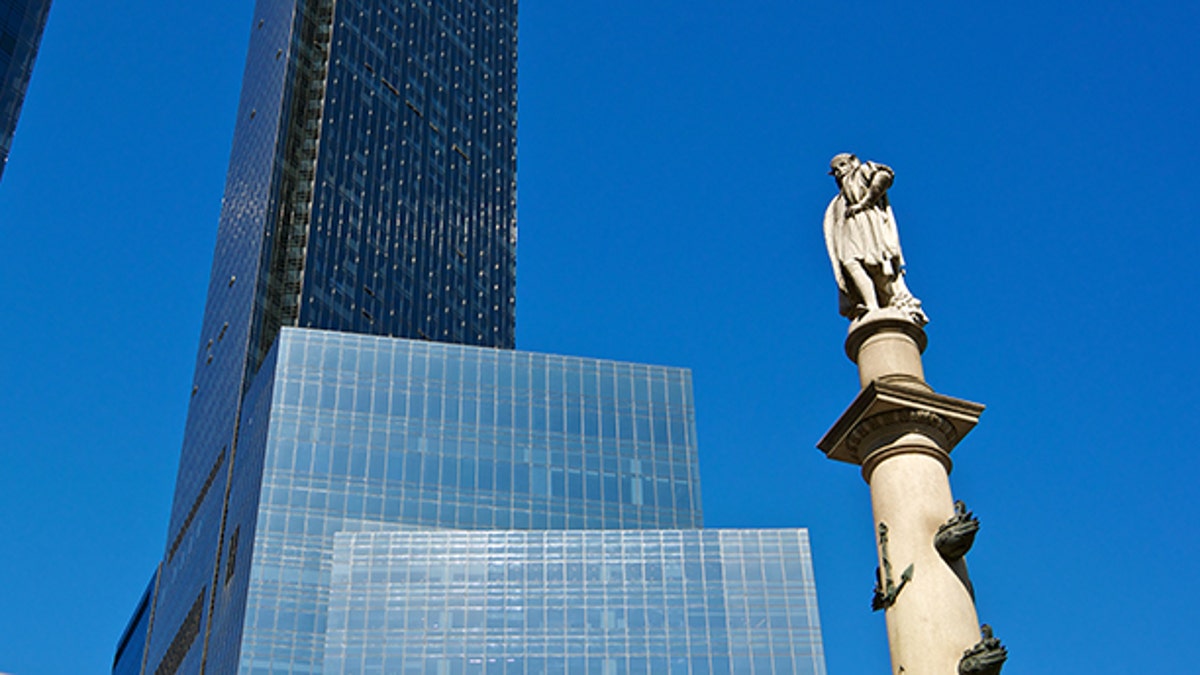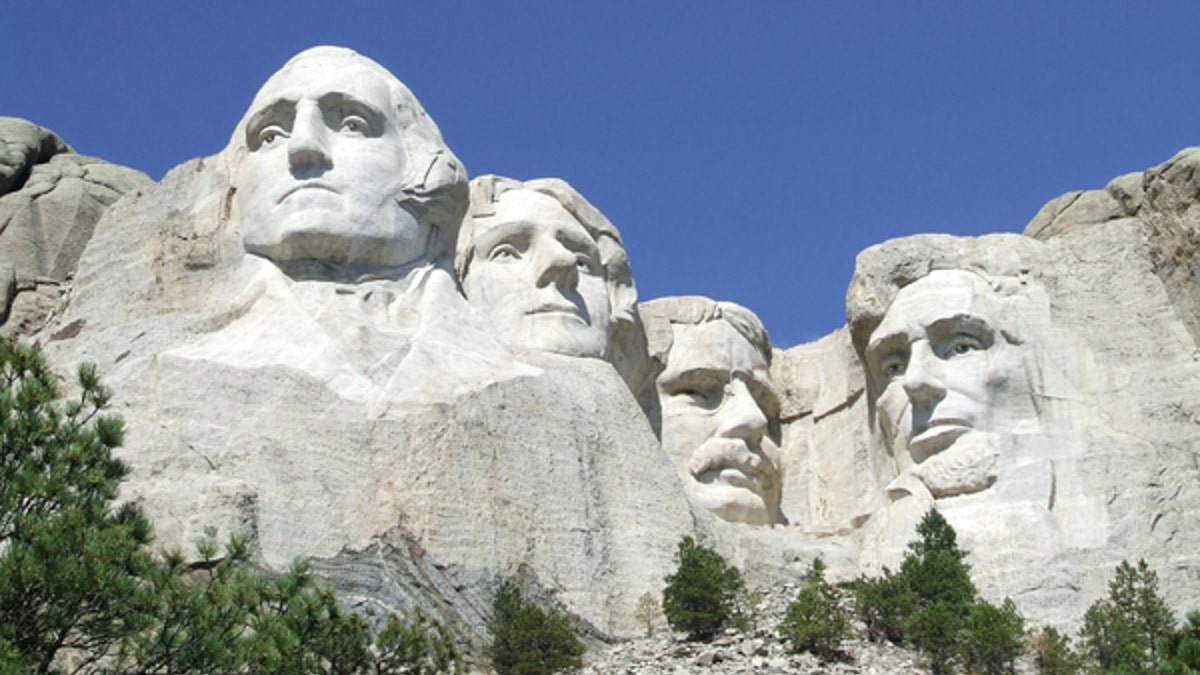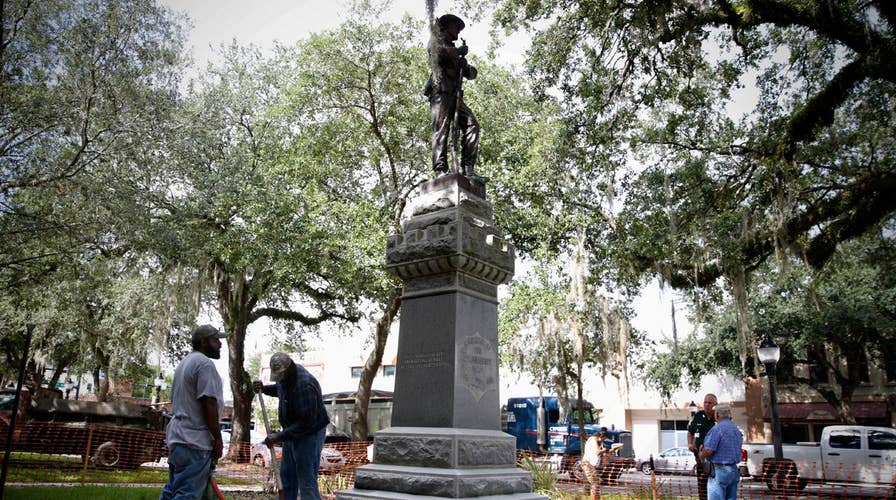It’s open season on statues.
Or so it seems: This month’s violence between white supremacists and counterprotestors over removing a statue of Confederate Gen. Robert E. Lee in Charlottesville, Va., has fast-tracked plans to take down some of the nation’s 718 memorials to the Confederacy. But it also has unleashed a rash of demands that long-standing and hitherto innocuous statues and memorials be destroyed.
Fox News has compiled a list of five memorials and monuments that are now alleged to be deeply offensive and in need of disposal.

"A cityscape view of the 1892 completed monument to Christopher Columbus, located in Columbus Circle at W.59th Street alongside of Broadway to the West. In the background is the 1990's completed world headquarters of the Time Warner Corporation, it's twin towers dominate the skyline in Upper Midtown Manhattan, New York City." (JayLazarin)
Columbus Circle statue (New York): Sitting on the southwestern edge of Central Park, Columbus Circle is one of the Big Apple’s most iconic locales. Since 1905, a statue of Christopher Columbus has stood atop the 76-foot tall monument, but in recent years – as the explorer’s life and legacy is re-examined – some have started calling for its removal.
Many Italian-Americans view Columbus as a hero responsible for discovering the New World and have turned the city’s Columbus Day Parade into a celebration of Italian heritage. Others, particularly those in New York’s large Puerto Rican and Dominican populations, believe history should not be so kind to Columbus, saying he used enslavement, disease and trickery to oppress and kill thousands of indigenous people in the Americas.
Now as the city reviews which statues to potentially purge in the wake of Charlottesville, New York City Council Speaker Melissa Mark-Viverito wants Columbus added to the chopping block. New York City Mayor Bill de Blasio has not offered his opinion, but added that the Columbus statue is “one of the ones that will get very immediate attention because of the tremendous concerns about it.”
Despite the recent recasting of Columbus – and the prominence of the busy traffic circle – many New Yorkers say they did not know that the explorer was such a contentious historical figure.
“I never knew Christopher Columbus was so controversial,” Robin Kelly, who lives near Columbus Circle, told Fox News. “I just though he sailed the ocean blue.”

Shown is a statue of the late Philadelphia Mayor Frank Rizzo, who also served as the city's police commissioner outside the Municipal Services Building in Philadelphia, Friday, Aug. 18, 2017. (AP Photo/Matt Rourke)
Frank Rizzo statue (Philadelphia): The 10-foot-tall bronze statue of the former Philadelphia mayor and police commissioner sits just to the side of City Hall. While there have been calls for years to bring down the statue of the man who has been posthumously called the “Joe Arpaio of eastern Pennsylvania,” the demands have reached a fever pitch since Charlottesville. Last week someone was cited for disorderly conduct for throwing eggs at the hulking likeness of Rizzo and on Friday Philadelphia police arrested a man who had spray-painted the words “black power” on the statue.
Philadelphia has struggled for years to reconcile the legacy of Rizzo, who served as mayor from 1972 to 1980 and died in 1991. His fans remember him as a devoted public servant and defender of the middle class who was unafraid to speak his mind. His detractors saw his police force as corrupt and brutal and said Rizzo alienated and targeted minorities both as police commissioner and mayor. Democratic Councilwoman Helen Gym tweeted last week that the Rizzo statue should be removed, and Democratic Mayor Jim Kenney said Tuesday it's the "right time" for a conversation about the statue.

Courtesy NPS/Handout via REUTERS (Mount Rushmore)
Mount Rushmore (Black Hills, S.D.): Each year around 3 million tourists from around the globe flock to the desolate Black Hills region of South Dakota to view the 60-foot high stone faces of President George Washington, Thomas Jefferson, Theodore Roosevelt and Abraham Lincoln. Those faces, along with its scale, ambition and the audacity to turn a massive mountain face into a presidential monument, have made Mount Rushmore both a beloved American icon and a heated symbol of Manifest Destiny.
The fight against Mount Rushmore began in earnest in the 1970s when the American Indian Movement led an occupation of the mountain with Lakota holy man John Fire Lame Deer planting a prayer staff on the summit of the mountain. Lame Deer said that the staff was a shroud over the presidents' faces "which shall remain dirty until the treaties concerning the Black Hills are fulfilled.” The monument was built on land seized from the Lakota following the Great Sioux War of 1876, before which the Black Hills were granted in perpetuity to the Lakota under the Treaty of Fort Laramie in 1868.
In response to the completion of Mount Rushmore in 1941, some members of the Lakota tribe began carving a monument to famed Oglala warrior Crazy Horse into the side of Thunderhead Mountain – roughly 17 miles from Rushmore. Construction of the monument, which began in 1948 and is far from complete, has itself not been without controversy as some descendants of Crazy Horse and the traditional Lakota question whether he would have approved of his likeness being carved into the side of a pristine mountain and are upset his family was not consulted before dynamiting of the rock began.

V.I. Lenin statue in Seattle (Britta Pedersen/dpa via AP)
V.I. Lenin Statue (Seattle): Following the collapse of the Soviet Union, hundreds of statues and monuments to communist leaders were torn down and either destroyed or put into special parks across the former USSR. So how did a 16-foot-tall bronze sculpture of Vladimir Ilyich Ulyanov -- better known to the world as Lenin – end up in the trendy Seattle neighborhood of Fremont?
The statue of the man arguably responsible for the birth of the Soviet Union was brought to the U.S. by Lewis Carpenter, an English-language teacher who was working in Slovakia when he found the sculpture lying in a scrapyard with a homeless man living inside it. Carpenter had originally planned to put the statue in front of a Slovak restaurant, but he died in a car accident and through a few twists of fate the likeness of Lenin ended up on display in Fremont until a private buyer could be found for it.
That was in 1995.
Since then the Lenin statue has become a popular attraction in the counterculture-embracing Fremont, but it has also generated a number of calls for its removal. In 2014, following the Russian military intervention in the Ukraine, the Lithuanian envoy to Washington, D.C., warned that “one day you will wake up and instead of 'Go Huskies' Seattle residents will instead see Russian license plates on military vehicles in their city.”
And following the protests in Charlottesville, alt-right activist Jack Posobiec led a gathering of several protesters at the statue to demand its removal. Seattle Mayor Ed Murray also recently called for the statue's removal, along with a Confederate memorial at Lake View Cemetery. But because both the statue and the property it sits on are privately owned, neither Murray nor the city council has the power to actually tear down Lenin.

Baphomet monument in Detroit (Reuters)
Baphomet Monument (Detroit): With all the battles raging over Confederate monuments, one would think calls to remove a statue of a mythical satanic goat deity would be pretty cut and dry.
Not so.
The Satanic Temple, a political activist group and religious organization, announced plans in 2014 to build a monument to the goat deity Baphomet at the Oklahoma State Capitol in response to a Ten Commandments Monument installed by Oklahoma state Rep. Mike Ritze in 2012. Following the vandalism of the Ten Commandments monument and a ruling by Oklahoma’s Supreme Court declaring all religious displays illegal, however, the Satanic Temple moved the statue to a warehouse in Detroit.
The unveiling of the Baphomet monument in Detroit drew widespread protests from Christian organizations in the city, but also saw 700 people sell their souls to Satan in order to receive a ticket to the event -- a tactic used by the Temple to "keep away some of the more radical superstitious people who would try to undermine the event."
The Satanic Temple had planned to move the statue to the Arkansas statehouse, in protest of a Ten Commandments monument being erected there, but their plans were stymied when a 32-year-old man plowed his Dodge Dart into the Ten Commandments monument in June, less than 24 hours after it was installed.

Missy Elliott
One More: There actually has been a proposal to replace a memorial to Confederate soldiers with a statue of Missy Elliott.
A petition on Change.org is currently looking for signatures to support replacing a Confederate monument in Portsmouth, Va., with one of hometown hero Missy “Misdemeanor” Elliott.
“Hailing from humble beginnings as the only child of a power company dispatcher and a welder at Portsmouth's lauded naval shipyard, she rose to become a platinum recording artist with over 30-million albums sold,” Nathan Coflin, who started the petition wrote. “All this without even once owning a slave.”
Coflin added: “Missy is all of us. Missy is everything the Confederacy was not.”
The petition currently has over 27,000 of the 35,000 needed signatures.






















